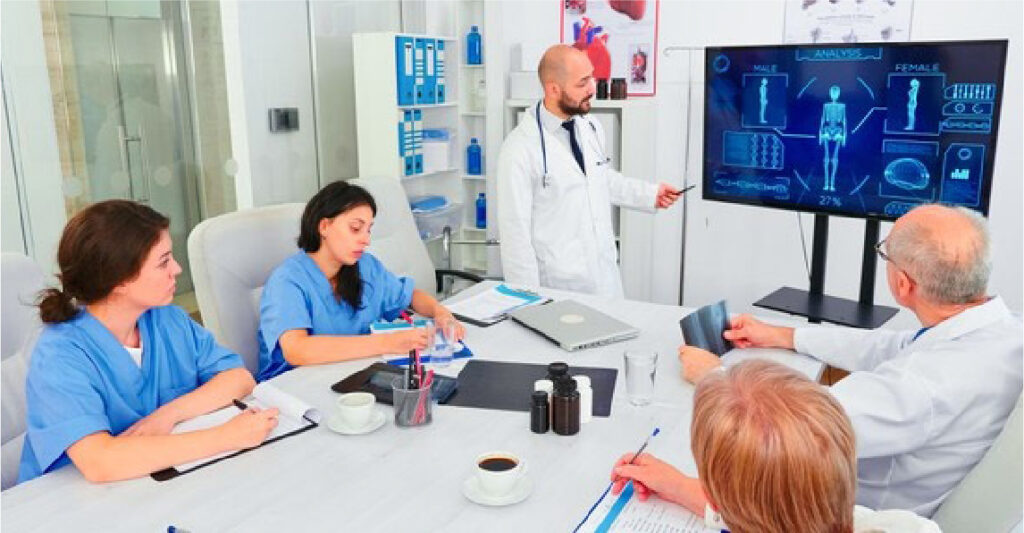By Rich Fries, Vice President of Technology, and Dr. Steven Dain, Chief Medical Informatics Officer
I remember learning about Moore’s Law when I took my first course in computer science. This axiom holds that computer processor performance doubles every two years, which is equivalent to an annual compound increase of about 40 percent. To give you a real-world example of this law in action, we now have the same computing power in our cell phones that used to require a room full of mainframes. It also is what makes possible such marvels as cloud computing, telehealth, AI, and the Internet of Medical Things (IoMT) – all of which have literally revolutionized healthcare.
On face value, this exponential growth of computing power promises more and better solutions to the challenges facing the healthcare industry and especially providers. Need to monitor patient vitals and post-discharge compliance remotely in real time? No problem – wearable 5G technology can make this possible. Need to capture and record patient treatment data in an EHR along with medical device usage and costs, analyze this data, and then share it with payors, patients and other medical team members while all the time complying with HIPAA? No problem – cloud computing, big data, encryption and firewalls come to the rescue.
But from where we sit as heads of technology at a cutting-edge medical device company, this explosion in computing capacity, platforms and applications can also create a veritable Pandora’s Box where the technology itself gets ahead of providers’ IT teams’ ability to maximize its benefit to patient treatment outcomes, provider operations, and population health. When this happens, the technology can start to drive management and patient care decisions, rather than the other way around. And, as you can imagine, this is not good for anyone.
If I were asked what the biggest obstacles are to staying in front of technological innovation and to fully realizing its promise, I would say the first is interoperability, the second would be staff training and adoption, and the third would be cybersecurity. So, let’s look at each obstacle and what providers can do to overcome them.

Interoperability
I mentioned interoperability first since it is easily the biggest stumbling block to incorporating new technologies into an organization’s operations. In some ways, it is the holy grail of healthcare IT systems. Given that in one recent year, organizations invested over $7 billion in digitalization programs, as an IT manager, making sure that technologies can “talk” with legacy technologies is of paramount importance. Imagine purchasing a new, state-of-the-art patient monitoring and treatment management system only to find that it will not readily or easily share information with an existing EHR, revenue cycle management, telemedicine or remote communications platform.
Interoperability and data sharing in healthcare have always been somewhat of a double edge sword. On the one hand, you need the free flow of information to realize the full promise of the technology – such as better care coordination, better patient and staff satisfaction, and more data-driven patient care and operational improvements. But at the same time, given the sensitive nature of patient information, privacy and security are paramount.
IT directors are also keenly aware that this need for efficient and secure interoperability will only increase over time. This is evidenced by data that show that some two out of every three older Americans have at least two chronic behavioral or physical conditions and that the treatment for patients with multiple conditions currently represents more than 60 percent of healthcare costs.
What is encouraging, however, is that the demands of the pandemic have accelerated innovation in healthcare technology, including in interoperability. Given that some 90 percent of U.S. hospitals now use EHR data to make clinical decisions, these innovations could indeed be seen as a silver lining to the challenges providers have had to face as the pandemic continues to push their operations to the limit.
The industry continues to develop interoperable solutions, with more on the horizon. These include vendor-neutral equipment that can interface with medical and non-medical devices and applications from other IT companies, and establishing and adopting standards such as FHIR, HL7, SNOMED, and CDISC. Vendors and organizations also need to “bake in” privacy and security protocols into their interoperability standards.

Staff Training and Adoption
In talking with my counterparts at a range of healthcare organizations– from community hospitals to SNFs – I often hear about what I like to call the “Field of Dreams” syndrome. In that movie of the same name, there is a famous line about “If you build it, they will come.” In our healthcare context, it means that many provider management teams believe that if they invest in IT, that staff will automatically accept it, learn it, and then use it (they may even be grateful). The reality however is that we are creatures of habit, we like what we know, and most of us don’t like change and especially technological change.
This resistance has much more to do with the reality of the demands on staff – and especially nursing and other patient-facing staff – than it does with not wanting to learn per se. They are very busy, juggling any number of tasks, and asking them to add learning new technology will not be high on their priority lists, especially in the case of physicians that are often told to learn new systems during time away from their family. But organizations must take steps to ensure proper training, since without it, staff may make errors which could endanger patient health, increase operating costs, and negatively impact an organization’s reputation in the community. Lack of technological proficiency may also increase the risk of noncompliance with meaningful use procedures, which could reduce both an organization’s and a provider’s Medicare reimbursement levels.
What we have seen that works very well is a two-pronged approach to bringing new technology – whether medical devices, EHR or financial systems – that focuses on an easy to learn, easy to use and easy to remember end-user experience of the new technology, and rapidly bringing them up-to-speed on how to use it to enhance patient care, while simultaneously making their lives easier. If you tell ICU nursing staff, for example, that a new bedside system, such as DocBox’s Clinician Assistant in Critical Care™ , is intuitive and easy to use and improves patient care while freeing up 70 percent of their time previously spent on manual administrative takes, we can pretty much guarantee they will readily embrace it!
The training component also needs to be tailored to staff time demands and learning styles. For many, this means hands-on learning in a real-world or virtual reality setting rather than through more traditional textbook or interactive online training.

Cybersecurity
While hackers can harm companies in any sector, they can be especially damaging in healthcare. In addition to the financial aspects of a data breach, which can be up to three times higher for healthcare companies, providers also need to consider the impact on patient care. To give you an example, the U.S government several years ago warned that hackers had the ability to take control of infusion pumps and instruct them to deliver lethal medication doses to patients. The possibility of hackers using medical devices – such as pacemakers, insulin pumps and deep brain neurostimulators – connected to data networks to harm patients is what causes nightmares for IT directors.
Recognizing this risk, the U.S. Food and Drug Administration requires that medical device manufacturers repair and report potential device issues that make them prone to attack. And, for their part, organizations need to continue to take steps to reduce the possibility of a cyberattack, including limiting equipment access and enhanced security protocols. They also need to continuously be on the lookout for problems with user authentication, weak email security protocols, and having too many authorized users with access to sensitive information or medical devices. Another important step is conducting cybersecurity training across all staff functions and levels.
Cybersecurity is so critical that industry analysts estimate that the healthcare industry will spend upwards of $125 billion on cybersecurity products over the period 2020 – 2025. While this is almost an astronomical amount, it is not all that surprising given that healthcare may fall victim to up to three times the number of attacks than in other sectors. Solutions need to be built from the ground up with cybersecurity in mind, rather than adding more levels of complexity to secure devices.
Given the millions of dollars organizations are investing in healthcare technology, CTOs and CIOs will continue to be under enormous pressure to demonstrate the value of these investments to improve patient outcomes, rates of readmission, staff satisfaction and population health. To do this, they will need to make sure they are the masters and drivers of this technology and not the other way around!













